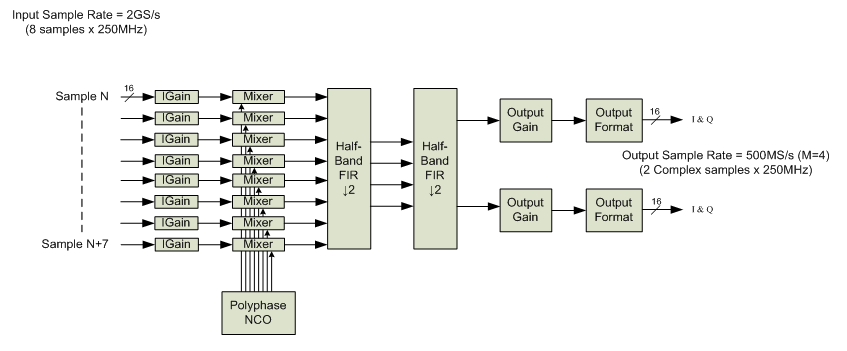
Wideband Analog to Digital Converter and Digital to Analog Converter technology has comfortably moved into the GSPS speed range, covering L-band and beyond with good resolution. Direct Radio Frequency (RF) solutions are here with increasingly wider bandwidths coming through. There are great advantages with direct radio frequency solutions, principally resulting in size, weight and power (SWaP) improvements, but this comes with the increased danger of swamping processors and busses. Most applications are only interested in specific pieces of the frequency spectrum. With so much excessive data, Digital Down Conversions (DDC) have never been needed more to remove the chaff of unwanted data. Even when using correspondingly faster processors, choosing not to remove the irrelevant data will quickly drag down system performance.
Digital down converters with wideband data input need careful design, and even then may still require application specific optimization to achieve design goals. This can include filter selectivity or the amount of processing resource required to implement it. There are different classes of digital down converters including narrow band, multi-channel narrow band, wide band and ultra-wide band. The realm of digital down converters operating with very high data throughput is ideally suited to FPGAs both in terms of speed and customization options as they form the gateway between ADC hardware interface to the backend processing busses. Most modern wideband digital down converters are increasingly being implemented in FPGAs for this reason. However, these designs are not trivial and often they are intimately crafted for the specific hardware they are required to work on in order to overcome the key challenges.
In one respect, the digital down converter is a mundane but important component for the system developer. In another, the digital down converter IP is an extension of the hardware. System developers may prefer an optimized piece of the digital down converter IP to get the most out of the target hardware from the vendor most intimate with the hardware: the hardware vendor. This allows the developer to focus on the task of processing the real data of interest secure in the knowledge that it is efficient and coherent while maximizing their available processing resource.

Download the white paper on Wideband DDC as Part of an Integrated Approach to learn more about:
- Digital down conversion (DDC) trends
- The anatomy of the digital down converters
- Challenges of direct RF sampling
- Customizing the digital down converters